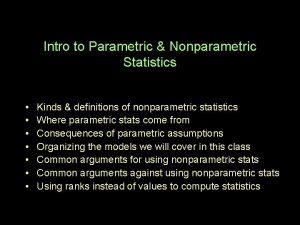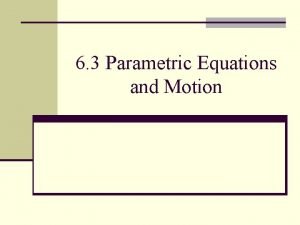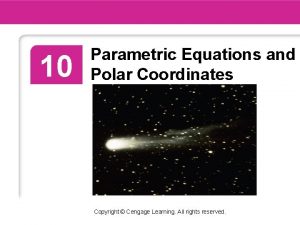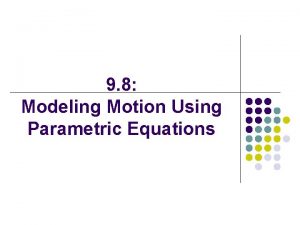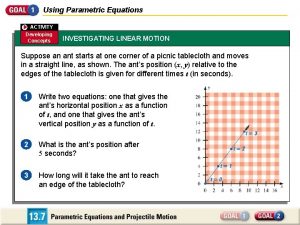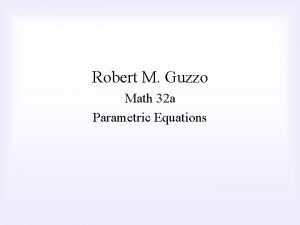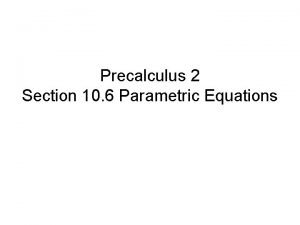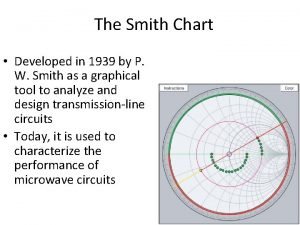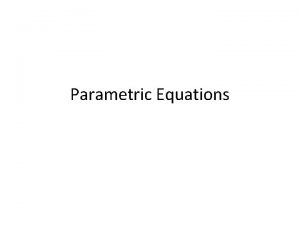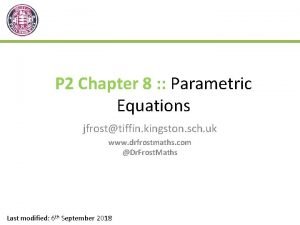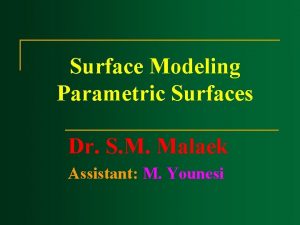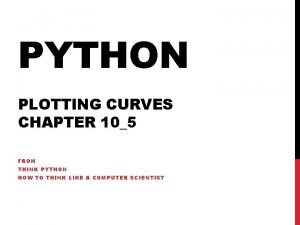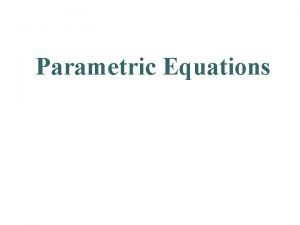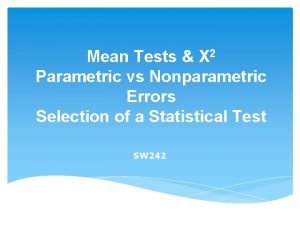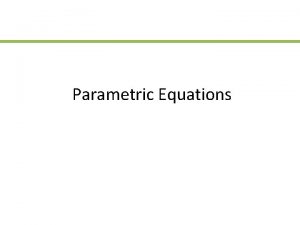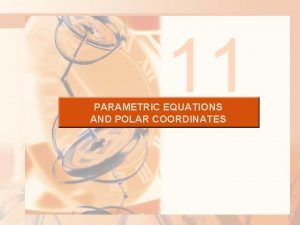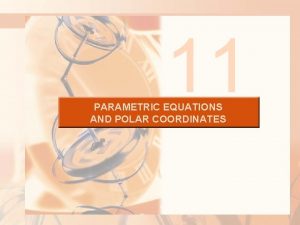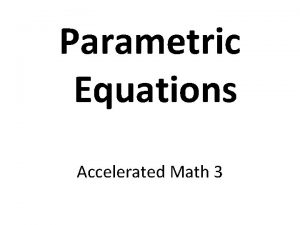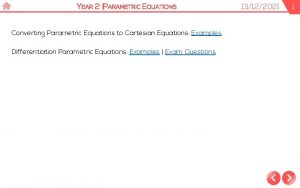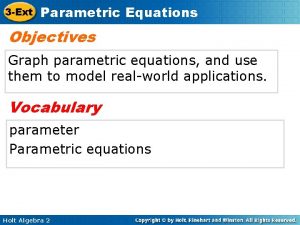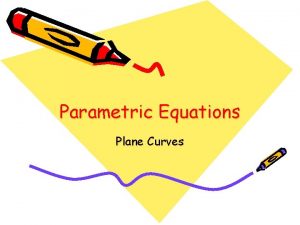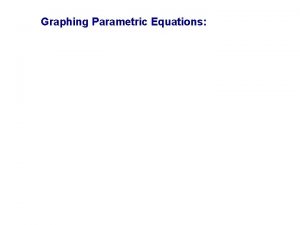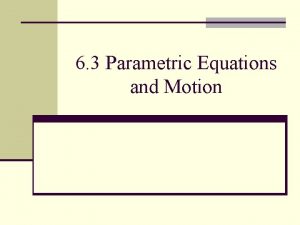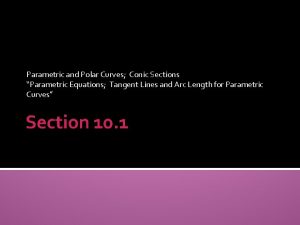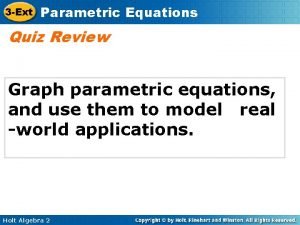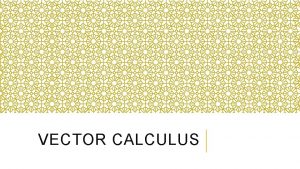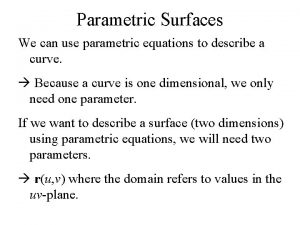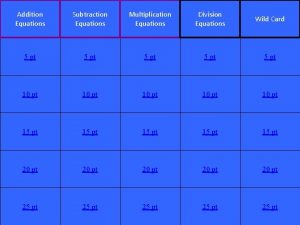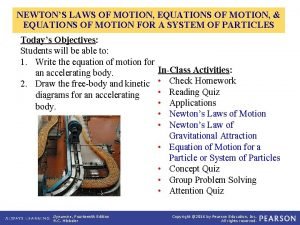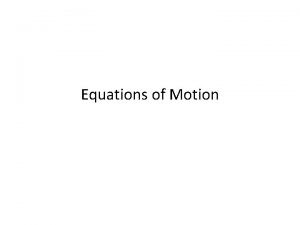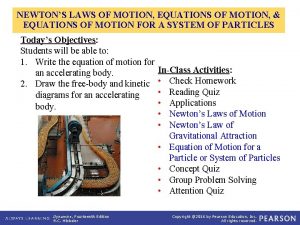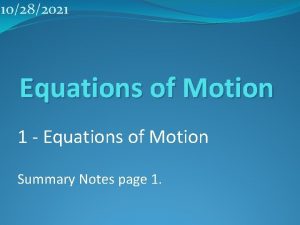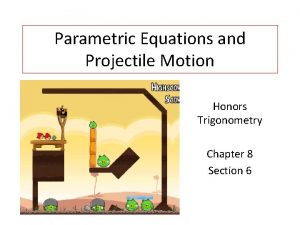6 3 Parametric Equations and Motion I Definition
























- Slides: 24

6. 3 Parametric Equations and Motion

I. Definition A. ) Parametric Curve – Graph of ordered pairs (x, y) where x = f(t) and y = f(t). B. ) Parametric Equations– Any equation in the form of x = f(t) and y = f(t). t is called the parameter on an interval I.

C. ) Ex. 1– “Old School” – A ball is thrown in the air with an initial velocity of 32 ft. /sec from a height of 6 ft. Write an equation to model the height of the ball as a function of time. Let’s look at the graph

(1, 22) (0, 6) (2, 6)

If the ball is thrown directly upward, we can model the position of the ball using two different functions of t. The horizontal position of the ball is now on a vertical axis, as it is in “real-life”. While the graph models its vertical position with respect to time, we can also see the velocity and the acceleration by changing our mode to parametric and our line to -0

II. Graphing by Hand A. ) Ex. 2 - Graph the following parametric equation by hand. t Make a table: -2 -1 0 1 2 3 x y

t x y -2 2 -6 -1 -1 -3 0 -2 0 1 -1 3 2 2 6 3 7 9

III. Eliminating the Parameter A. ) Ex. 3 - Determine the graph to the parametric equation by eliminating the parameter.

B. ) Ex. 4 - Determine the graph to the parametric equation by eliminating the parameter. Very unfamiliar and hard to work with!!!

What if we squared both sides of both equations? Now, add the equations! The circle centered at the origin with a radius of 1

IV. Lines and Line Segments A. ) Ex. 5 - Find the parameterization for the line through the points (-3, -3) and (5, 1). B A

Let P(x, y) be a point on the line through A and B and let O be the origin. The vector is a scalar multiple of the vector O B P A


B. ) Ex. 6 - Find the parameterization for the line through the points A=(3, 4) and B=(6, -3).

What if we wanted the line segment with endpoints A and B? Which values of t produce these endpoints?

V. Simulating Motion A. ) A particle moves along a horizontal line so that the position s (in feet) at any time t ≥ 0 seconds is given by the function B. ) Ex. 7 - Estimate the values at which the particle changes direction given

Graph it. Place the equation in X 1 T and choose an arbitrary Y 1 T value. What kind of window do we need? Trace it.

Another way: Let Y 1 T = T. Window: Now we can visually see when the particle changes direction!

VI. Projectile Motion A. ) Not everything is straight vertically or horizontally. Take for example, hitting a baseball. There is both a horizontal and vertical component. The velocity vector is The path that the object takes can be modeled by the parametric equations Horizontal Distance Vertical Position

B. ) Ex. 8 - Sally hits a softball 2. 5 feet above the plate with an initial speed of 110 feet per second at an angle of 22º with the horizontal. Will the ball clear the 5 ft. fence 250 feet away? First, determine the equations for the ball: Now, determine the window Now, graph and trace to see if it clears the wall

C. ) Determine the equations for the wall: Change your MODE to Simultaneous Now, just graph to see if it clears the wall D. ) General the equation for the wall:

VII. Modeling Ferris Wheels A. ) Ex. 9 - A Ferris wheel with a radius of 20 feet makes 1 complete revolution every 10 seconds. The lowest point of the Ferris wheel is 5 feet above the ground. Determine the parametric equations which will model the height of a rider starting in the 3 o’clock position at t = 0.

1. ) Center the Ferris wheel on the vertical axis such that the center will be at the point (0, 25). We know, from Chapter 5 that But, θ must be in terms of t. Since it takes 10 sec. to complete 1 revolution,

Therefore, and
 Univariate analysis tests
Univariate analysis tests Parametric test and non parametric test
Parametric test and non parametric test Boris epshtein
Boris epshtein Parametric
Parametric Parametric equation of motion
Parametric equation of motion Polar curve
Polar curve Chapter 7 conic sections and parametric equations
Chapter 7 conic sections and parametric equations Parametric projectile motion
Parametric projectile motion In a pumpkin tossing contest in morton illinois
In a pumpkin tossing contest in morton illinois Parametric equations word problems
Parametric equations word problems Cartesian equation
Cartesian equation How to solve parametric equations
How to solve parametric equations Complete smith chart
Complete smith chart Parametric equations
Parametric equations Dr frost parametric equations
Dr frost parametric equations Types of statistics
Types of statistics Texture synthesis by non-parametric sampling
Texture synthesis by non-parametric sampling Surface modelling in cad
Surface modelling in cad Matplotlib parametric plot
Matplotlib parametric plot Example of parametric statistics
Example of parametric statistics Wskim
Wskim Parametric insurance nat cat
Parametric insurance nat cat Cycloid equation cartesian
Cycloid equation cartesian Parametric vs nonparametric test
Parametric vs nonparametric test Parametric integration
Parametric integration



